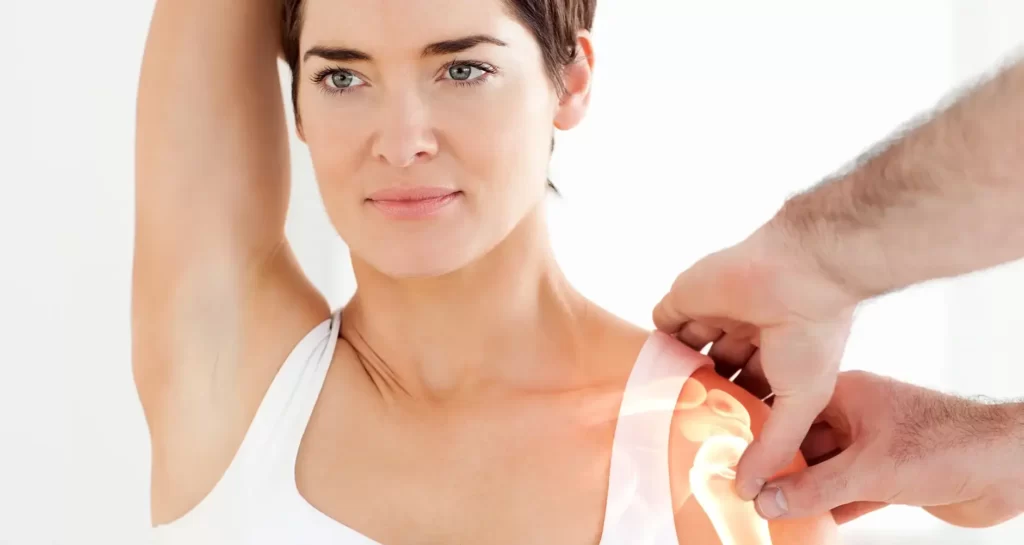What is shoulder pain?
Shoulder pain can be a result of injury or disease of the shoulder joint. Injury can affect any of the ligaments, bursae, or tendons surrounding the shoulder joint. Injury can also affect the ligaments, cartilage, menisci (plural for meniscus), and bones of the joint. The design of the shoulder joint is such that it sacrifices stability for mobility. As an extremely mobile joint that plays a central role in the action of a major extremity, the shoulder is at risk for injury.
What causes shoulder and neck pain?
The most common cause of shoulder pain and neck pain is injury to the soft tissues, including the muscles, tendons, and ligaments within these structures. This can occur from whiplash or other injury to these areas. Degenerative arthritis of the spine in the neck (cervical spine) can pinch nerves that can cause both neck pain and shoulder pain. Degenerative disc disease in the neck (cervical spondylosis) can cause local neck pain or radiating pain from disc herniation, causing pinching of nerves (cervical radiculopathy). Abnormal conditions involving the spinal cord, heart, lungs, and some abdominal organs also can cause neck and shoulder pain. Here are some examples:
Broken collarbone: Falling on your outstretched arm can cause your collarbone to break. This is particularly common when cyclers fall off of their bicycles.
Bursitis: A bursa is a sac over the joints to provide a cushion to the joints and muscles. These bursae can become swollen, stiff, and painful after injuries.
Broken shoulder blade: An injury to the shoulder blade usually is associated with relatively forceful trauma.
Rotator cuff injuries: The rotator cuff is a group of tendons that support the shoulder. These tendons can be injured during lifting, when playing sports with a lot of throwing, or after repetitive use over a long time. This can lead to pain with motion of the shoulder due to shoulder impingement syndrome and eventually to a chronic loss of range of motion of the shoulder (frozen shoulder).
Shoulder or A-C separation: The collarbone (clavicle) and shoulder blade (scapula) are connected by ligaments. With trauma to the shoulder, these ligaments can be stretched or torn.
Tendonitis: The tendons connect the muscles to the bones. With strain, the tendons can become swollen and cause pain. This is also referred to as tendinitis.
What are risk factors for shoulder pain?
Risk factors for shoulder include athletic activity, heavy lifting, throwing, moving luggage or other heavy objects, and aging.
What are the symptoms and signs of shoulder pain?
Pain: All pain seems sharp, but pain can also be described as dull, burning, crampy, shock-like, or stabbing. Pain can lead to a stiff neck or shoulder and loss of range of motion.
Weakness: Weakness can be due to severe pain from muscle or bone movement. The nerves that supply the muscles, however, also could be injured. It is important to distinguish true weakness (muscle or nerve damage) from inability or reluctance to move because of pain or inflammation.
Numbness: If the nerves are pinched, bruised, or cut, you may not be able to feel things normally. This may cause a burning or tingling sensation, a loss of sensation, or an altered sensation similar to having your arm “fall asleep.”
Coolness: A cool arm or hand suggests that the arteries, veins, or both have been injured or blocked. This may mean that not enough blood is getting into the arm.
Color changes: A blue or white tinge to the skin of your arm or shoulder is another sign that the arteries or veins could have been injured. Redness can indicate infection or inflammation. Rashes may be noted as well. Bruising may be evident.
Swelling: This may be generalized to the whole arm or may be localized over the involved structures (a fracture area or an inflamed bursa, for example). Muscle spasms or tightness may simulate actual swelling. Dislocation or deformity may cause a swollen appearance or, paradoxically, a sunken area.
Deformity: A deformity may be present if you have a fracture or a dislocation. Certain ligament tears can cause an abnormal positioning of the bony structures.
How can I prevent shoulder and neck pain?
To prevent injuries, examine your home for potential hazards and correct them to reduce the chance of accidental injury.
Proper exercise of the shoulders can reduce the risk of injury.
When performing hazardous tasks, have someone present to reduce the likelihood of injury. For example, when climbing a ladder, have someone hold the base of the ladder to keep it from sliding to either side.
Know your limitations. Do not perform activities that you do not have the training, skills, tools, or strength to accomplish.
Wear seat belts and use other safety equipment to reduce injuries.
What is the prognosis for shoulder pain?
Because shoulder pain is caused by sprains and strains, you can expect a full recovery or to recover with minor limitations on your activities.
Some conditions require hospitalization, surgical repair, physiotherapy, or other rehabilitative measures. The extent of recovery may be complete or limited. Some conditions can be recurrent or persistent; thus, you should have a treatment plan to learn how to deal with and adapt to any limitations.



